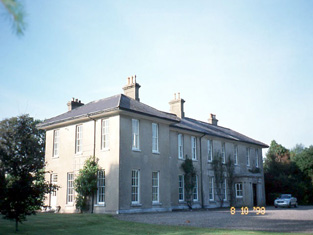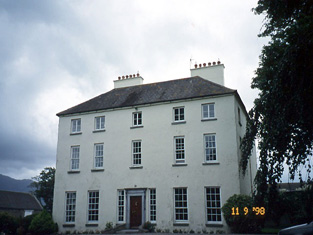Cullenagh House
Houses within 5km of this house
Displaying 8 houses.
Houses within 5km of Cullenagh House
Displaying 8 houses.
| House name | Description | |
|---|---|---|
| The Reeks or Baunclune | The McGillycuddy was in possession of the property at Whitefield at the time of Griffith’s Valuation when it was valued at £24 10s. Lewis and Leet also refer to Whitefield as a seat of The McGillycuddy in 1837 and 1814 respectively. Leet, however, also notes McGillycuddy Reeks as the address of McGillycuddy esq. In 1906 it was McGillycuddy property and valued at £24. Bary states that the house was originally known as The Reeks after the family title but that it was changed to Whitefield in the early 19th century by Richard McGillycuddy. However, on both the 1st and 25-edition Ordnance Survey maps it is labelled Baunclune. In more recent times it is known as The Reeks. This is how it is referred to by the Irish Tourist Association surveyor in the early 1940s who states that it was the the home of "Ross Kinloch, the MacGillycuddy of the Reeks and a member of Seanad Eireann". The house is still extant and occupied. |

|
| Grenagh House | Denis Lawlor was leasing Grenagh House from Henry Herbert’s estate at the time of Griffith’s Valuation when it was valued at £23 15s. Lewis mentions Grena as the seat of John O’Connell in 1837. The Ordnance Survey Name Books indicate that it was built by Mrs. Delaney in 1792. Bary states that O’Connell was obliged to leave the house due to debts. It then came into the possession of Denis Shine Lawlor and later again, Daniel James. It was afterwards the property of the O'Connor family but has been ruinous since the mid twentieth century. | |
| Lakeview | At the time of Griffith’s Valuation, James O’Connell was leasing the property from the Herbert estate when it was valued at £13. Lewis calls the house Lakeville in 1837. Leet also mentions a house called Lakeville in 1814 which he refers to as the residence of Francis Russell. Bary states that the existing house was built by James O’Connell in 1870 after he was made a Baronet but that there was an earlier house here also. The latter is mentioned as the residence of Mr. O'Connell in the Ordnance Survey Name Books of the 1830s. It was built in 1740 and located in the southern end of the townland. In 1894 Slater refers to Lakeview as the residence of Sir Maurice J. O'Connell. The house is still extant. |

|
| Churchtown | At the time of Griffith’s Valuation, Sir A. Blennerhassett was leasing Churchtown House to Robert Stokes. In 1837 Lewis refers to it as the seat of Sir A. Blennerhassett. Leet mentions it as the residence of R.A. Blennerhassett in 1814. The house was valued at £31. Churchtown House is still extant. Much of the demesne is now part of Beaufort Golf Course. |

|
| Beaufort | Reverend Edward Day was in possession of the house at Beaufort at the time of Griffith’s Valuation when it was valued at £37. Lewis refers to it as the seat of Frederick W. Mullins in 1837. In 1814 Leet also refers to it as the residence of Reverend F. Mullins. In 1786 Wilson refers to Beaufort as the seat of Hon. Dean Crosbie. Various sources, including Bary, indicate that it was built on the site of a tower house known as Short Castle. . It was sold by the Mullins estate in the mid nineteenth century to the Day family who sold it again in the 1880s. Referred to by Slater in 1894 as the seat of Lt-Col. E. Nash Leahy. It is still extant and occupied. |

|
| Cullenagh Lower | Myles Mahony was occupying a house at Cullenagh Lwr at the time of Griffith’s Valuation. It was valued at £6 and part of a holding of 176 acres. The house is not shown on thre 25-inch Ordnance Survey map of the 1890s. | |
| Dunloe Castle | At the time of Griffith's Valuation, Daniel Mahony was leasing Dunloe Castle from Thomas H. Broderick when it was valued at £15. Lewis describes it as formerly the seat of the O’Sullivan family but in 1837 the residence of D. Mahony. Leet refers to it as the residence of Daniel Mahony in 1814. Wilson, writing in 1786, mentions Dunloe Castle as the seat of Gustavus Crosbie. In 1894 Slater refers to it as the seat of John Mahony. The Irish Tourist Association surveyor notes that this property has associations with the United Irishmen and states that, in the early 1940s, it was owned by Agnes Petitt. Bary states that it remained in the Mahony family until the mid-20th century. The castle itself is now a ruin, located in the grounds of the Dunloe Castle Hotel. | |
| Tomies | In 1837 Lewis mentions Tomies as the seat of D.J. O'Sullivan. At the time of Griffith's Valuation, the property, valued at £5, was being leased by Daniel O'Sullivan from the Herbert estate. Bary states that this house was more usually associated with the O'Donoghue estate, citing references to "O'Donoghue of Tomies" in the local press. In 1906 Lord Ardilaun owned the property at Tomies East valued at £8 15s. It is now in ruins. |

